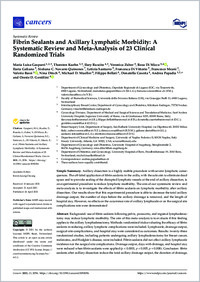Fibrin sealants and axillary lymphatic morbidity : a systematic review and meta-analysis of 23 clinical randomized trials
- Gasparri, Maria Luisa Department of Gynecology and Obstetrics, Ospedale Regionale di Lugano EOC, Lugano, Switzerland - Faculty of Biomedical Sciences, Università della Svizzera italiana, Switzerland
- Kuehn, Thorsten Interdisciplinary Breast Center, Department of Gynecology and Obstetrics, Klinikum Esslingen, Neckar, Germany
- Ruscito, Ilary Gynecology Division, Department of Medical and Surgical Sciences and Translational Medicine, Sant’Andrea University Hospital, Sapienza University of Rome, Rome, Italy
- Zuber, Veronica Breast Surgery Unit, Department of Surgery, San Raffaele University Hospital, Milan, Italy
- Di Micco, Rosa Breast Surgery Unit, Department of Surgery, San Raffaele University Hospital, Milan, Italy - Department of Clinical Medicine and Surgery, University of Naples Federico II, Naples, Italy
- Galiano, Ilaria Breast Surgery Unit, Department of Surgery, San Raffaele University Hospital, Milan, Italy
- Navarro Quinones, Siobana C. Emory University, Atlanta, GA, USA
- Santurro, Letizia Breast Surgery Unit, Department of Surgery, San Raffaele University Hospital, Milan, Italy
- Di Vittorio, Francesca Breast Surgery Unit, Department of Surgery, San Raffaele University Hospital, Milan, Italy
- Meani, Francesco Department of Gynecology and Obstetrics, Ospedale Regionale di Lugano EOC, Lugano, Switzerland
- Bassi, Valerio Department of Gynecology and Obstetrics, Ospedale Regionale di Lugano EOC, Lugano, Switzerland
- Ditsch, Nina Department of Gynecology and Obstetrics, University Hospital of Augsburg, Stenglinstraße 2, Augsburg, Germany
- Mueller, Michael D. Department of Obstetrics and Gynecology, University Hospital of Bern, Friedbühlstrasse 19, Bern, Switzerland
- Bellati, Filippo Gynecology Division, Department of Medical and Surgical Sciences and Translational Medicine, Sant’Andrea University Hospital, Sapienza University of Rome, Rome, Italy
- Caserta, Donatella Gynecology Division, Department of Medical and Surgical Sciences and Translational Medicine, Sant’Andrea University Hospital, Sapienza University of Rome, Rome, Italy
- Papadia, Andrea Department of Gynecology and Obstetrics, Ospedale Regionale di Lugano EOC, Lugano, Switzerland - Faculty of Biomedical Sciences, Università della Svizzera italiana, Switzerland
- Gentilini, Oreste D. Gynecology Division, Department of Medical and Surgical Sciences and Translational Medicine, Sant’Andrea University Hospital, Sapienza University of Rome, Rome, Italy
-
2021
Published in:
- Cancers. - MDPI. - 2021, vol. 13, no. 9, p. 15
English
Axillary dissection is a highly mobile procedure with severe lymphatic consequences. The off-label application of fibrin sealants in the axilla, with the sole aim to eliminate dead space and to provoke sealing of the disrupted lymphatic vessels at the end of axillary dissection, is an experimental procedure to reduce lymphatic morbidity. The aim of our systematic review and meta-analysis is to investigate the effects of fibrin sealants on lymphatic morbidity after axillary dissection. Our results show that this experimental procedure is able to decrease the total axillary drainage output, the number of days before the axillary drainage is removed, and the length of hospital stay. However, no effects on the occurrence rate of axillary lymphocele or on the surgical site complications rate were demonstrated Background: use of fibrin sealants following pelvic, paraaortic, and inguinal lymphadenectomy may reduce lymphatic morbidity. The aim of this meta-analysis is to evaluate if this finding applies to the axillary lymphadenectomy. Methods: randomized trials evaluating the efficacy of fibrin sealants in reducing axillary lymphatic complications were included. Lymphocele, drainage output, surgical-site complications, and hospital stay were considered as outcomes. Results: twenty-three randomized studies, including patients undergoing axillary lymphadenectomy for breast cancer, melanoma, and Hodgkin’s disease, were included. Fibrin sealants did not affect axillary lymphocele incidence nor the surgical site complications. Drainage output, days with drainage, and hospital stay were reduced when fibrin sealants were applied (p < 0.0001, p < 0.005, p = 0.008). Conclusion: fibrin sealants after axillary dissection reduce the total axillary drainage output, the duration of drainage, and the hospital stay. No effects on the incidence of postoperative lymphocele and surgical site complications rate are found.
- Language
-
- English
- Classification
- Medicine
- License
- Open access status
- gold
- Identifiers
-
- RERO DOC 333671
- DOI 10.3390/cancers13092056
- ARK ark:/12658/srd1319276
- Persistent URL
- https://n2t.net/ark:/12658/srd1319276
Statistics
Document views: 186
File downloads:
- Texte intégral: 236
